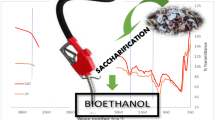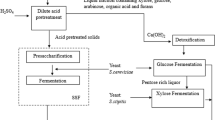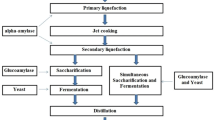Abstract
Hydrolysis and fermentation conditions for production of ethanol from very high-gravity cassava mash by Saccharomyces cerevisiae during simultaneous saccharification and fermentation (SSF) processing were optimized using a statistical methodology. During the first part of the study, Placket–Burman design (PBD) was used to study 19 factors that could potentially influence ethanol production. Gravity, particle size, initial pH, and fermentation temperature were identified as key factors that significantly increased final ethanol concentration. The main and interaction effects of these factors were subsequently evaluated based on a quadratic equation generated by central composite design (CCD) using response-surface methodology (RSM). Under the optimized very high-gravity conditions, the final ethanol concentration obtained from experiment increased from 8.21% (wt.%) to 15.03% (wt.%) and was in good agreement with model prediction. By employing two other commercial Saccharomyces strains, similar results were obtained under the same optimized condition. Therefore, we conclude that final ethanol concentration, ethanol productivity (V P/max), glucose utilization (Y G/s, Y P/s), and fermentation efficiency (η f) were enhanced or maintained under the optimized condition of 40% gravity, 390 μm particle size, initial pH 5.5, and 27°C fermentation temperature.


Similar content being viewed by others
References
Akhnazarova S, Kafarov V (1982) Experiment optimization in chemistry and chemical engineering. Mir, Moscow
Alfenore SC, Molina-Jouve SE, Guillouet JL, Uribelarrea G, Goma LB (2002) Improving ethanol production and viability of Saccharomyces cerevisiae by a vitamin feeding strategy during fed-batch process. Appl Microbiol Biotechnol 60:67–72
Alkasrawi M, Eriksson T, Büjesson J, Wingren A, Galbe M, Tjerneld F, Zacchi G (2003) The effect of Tween-20 on simultaneous saccharification and fermentation of softwood to ethanol. Enzym Microbial Technol 33(1):71–78
Amore TD (1992) Improving yeast fermentation performance. J Inst Brew 98:375–383
Antonio LRD, Minakata PE, Rosa DL, Barba AP, Blaschek HP (2008) Optimization of fermentation conditions for the production of the mezcal from Agave salmiana using response surface methodology. Chem Eng Process 47:76–82
Ayhan D (2009a) Political, economic and environmental impacts of biofuels: a review. Appl Energy 86:S108–S117
Ayhan D (2009b) Biofuels securing the planet’s future energy needs. Energy Convers Manag 50:2239–2249
Box GEP, Norman RD (1959) A basis for the selection of a response surface design. J Am Stat Assoc 54(287):622–654
Brian RG, Stephen JL, Jessica PRL, Chris DP, Katherine AS (2007) Yeast responses to stresses associated with industrial brewery handling. FEMS Microbiol Rev 31:535–569
Bryan MJ, Chris S, James JS (2009) Biofuels: growing toward sustainability. Calif Agric 63:155–159
Bvochora JM, Read JS, Zvauya R (2000) Application of very high gravity technology to the cofermentation of sweet stem sorghum juice and sorghum grain. Ind Crops Prod 11:11–17
Dai D, Hu ZY, Pu GQ, Li H, Wang CT (2006) Energy efficiency and potentials of cassava fuel ethanol in Guangxi region of China. Energy Convers Manag 47:1686–1699
Ferreira S, Duarte AP, Ribeiro MHL, Queiroz JA, Domingues FC (2009) Response surface optimization of enzymatic hydrolysis of Cistus ladanifer and Cytisus striatus for bioethanol production. Biochem Eng J 45:192–200
Hu CK, Bai FW, An LJ (2004) Mechanism for Mg2+ to enhance ethanol tolerance of fusant SPSC. Dalian Ligong Daxue Xuebao/J Dalian Univ Technol 44:228–232
Ingledew WM, Bayrock DP (2001) Application of multistage continuous fermentation for production of fuel alcohol by very-high-gravity fermentation technology. J Ind Microbiol Biotechnol 27:87–93
Joost VDB, Pascale DL, Jack P, Johannes DW (2008) New insights into the Saccharomyces cerevisiae fermentation switch: dynamic transcriptional response to anaerobicity and glucose-excess. BMC Genomics 9:100
Kosugi A, Kondo A, Ueda M, Murata Y, Vaithanomsat P, Thanapase W, Arai T, Mori Y (2009) Production of ethanol from cassava pulp via fermentation with a surface-engineered yeast strain displaying glucoamylase. Renew Energy 34:1354–1358
Koutinas AA, Arifeen N, Wang R, Webb C (2007) Cereal-based biorefinery development: integrated enzyme production for cereal flour hydrolysis. Biotechnol Bioeng 97:61–72
Kyung MY, Rosenfield CL, Knipple DC (2003) Ethanol tolerance in the yeast Saccharomyces cerevisiae is dependent on cellular oleic acid content. Appl Environ Microbiol 69:1499–1504
Li X, Jia OY, Xu Y, Chen M, Song XY, Yong Q, Yu SY (2009) Optimization of culture conditions for production of yeast biomass using bamboo wastewater by response surface methodology. Bioresour Technol 100:3613–3617
Manikandan M, Pasic L, Kannan V (2009) Optimization of growth media for obtaining high-cell density cultures of Halophilic archaea (family Halobacteriaceae) by response surface methodology. Bioresour Technol 100:3107–3112
McMeekin TA, Olley J, Ratkowsky DA, Ross T (2002) Predictive microbiology: towards the interface and beyond. Int J Food Microbiol 73:395–407
Moraes LMP, Astolfi-filho S, Oliver SG (1995) Development of yeast strains for the efficient utilization of starch: evaluation of constructs that express α-amylase and glucoamylase separately or as bifunctional fusion proteins. Appl Microbiol Biotechnol 43:1067–1076
Murray J (1994) X-Stat, version 2.02: statistical experimentation design, data analysis and nonlinear optimisation. Wiley, New York
Myers RH, Montgomery DC, Vining GG, Borror CM, Kowalski SM (2004) Response surface methodology: a retrospective and literature survey. J Qual Technol 36:53–77
Nikolic S, Mojovic L, Rakin M, Pejin D (2009) Bioethanol production from corn meal by simultaneous enzymatic saccharification and fermentation with immobilized cells of Saccharomyces cerevisiae var. ellipsoideus. Fuel 88:1602–1607
O’Connor-Cox ESC, Paik J, Ingledew WM (1991) Improved ethanol yields through supplementation with excess assimilable nitrogen. J Ind Microbiol Biotechnol 8:45–52
Pamment NB, Vriesekoop F, Barber AR (2007) Acetaldehyde mediates growth stimulation of ethanol-stressed Saccharomyces cerevisiae: evidence of a redox-driven mechanism. Biotechnol Lett 29:1099–1103
Patkova J, Smogrovicova D, Bafrncova P, Domeny Z (2000) Changes in the yeast metabolism at very high-gravity wort fermentation. Folia Microbiol 45:335–338
Placket RL, Burman JP (1946) The design of optimum multi-factorial experiments. Biometrika 33:305–325
Rivera EC, Costa AC, Atala DIP, Maugeri F, Maciel MRW, Filho RM (2006) Evaluation of optimization techniques for parameter estimation: application to ethanol fermentation considering the effect of temperature. Process Biochem 41:1682–1687
Srichuwong S, Fujiwara M, Wang X, Seyama T, Shiroma R, Arakane M, Mukojima N, Tokuyasu K (2009) Simultaneous saccharification and fermentation (SSF) of very high gravity (VHG) potato mash for the production of ethanol. Biomass Bioenergy 33:890–898
Thomas KC, Ingledew WM (1992) Production of 21% (v/v) ethanol by fermentation of very high gravity (VHG) wheat mashes. J Ind Microbiol Biotechnol 10:61–68
Thomas KC, Hynes S, Jone A, Ingledew MW (1993) Production of fuel alcohol from wheat by VHG technology. Appl Biochem Biotechnol 43:211–226
Wang S, Thomas K, Ingledew W, Sosulski K, Sosulski F (1998) Production of fuel ethanol from rye and triticale by very-high-gravity (VHG) fermentation. Appl Biochem Biotechnol 69:157–175
Yao YL, Lü ZM, Min H, Lü ZH, Jiao HP (2009) Isolation, identification and characterization of a novel Rhodococcus sp. strain in biodegradation of tetrahydrofuran and its medium optimization using sequential statistics-based experimental designs. Bioresour Technol 100:2762–2769
Zaldivar J, Nielsen J, Olsson L (2001) Fuel ethanol production from lignocelluloses: a challenge for metabolic engineering and process integration. Appl Microbiol Biotechnol 56:17–34
Zhang CH, Ma YJ, Yang FX, Liu W, Zhang YD (2009) Optimization of medium composition for butyric acid production by Clostridium thermobutyricum using response surface methodology. Bioresour Technol 100:4284–4288
Zhao XQ, Bai FW (2009) Mechanisms of yeast stress tolerance and its manipulation for efficient fuel ethanol production. J Biotechnol 144:23–30
Acknowledgments
This research was supported by the Ministry of Science and Technology International Cooperation Project 18-509J, Research Found of Science and Technology Bureau for the International Cooperation Project of Guangdong Province 2009B050800011.
Author information
Authors and Affiliations
Corresponding author
Rights and permissions
About this article
Cite this article
Yingling, B., Zongcheng, Y., Honglin, W. et al. Optimization of bioethanol production during simultaneous saccharification and fermentation in very high-gravity cassava mash. Antonie van Leeuwenhoek 99, 329–339 (2011). https://doi.org/10.1007/s10482-010-9494-5
Received:
Accepted:
Published:
Issue Date:
DOI: https://doi.org/10.1007/s10482-010-9494-5




